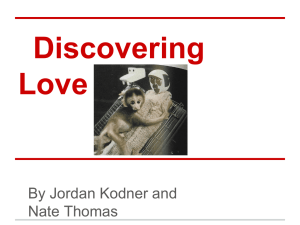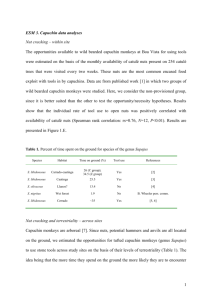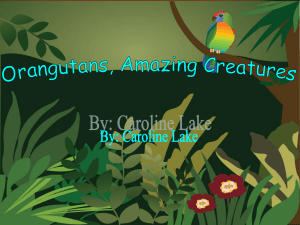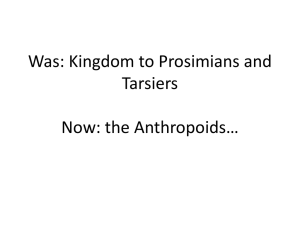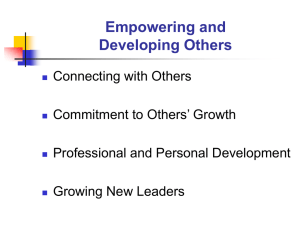COM-COM2-Morton20120176-R
advertisement
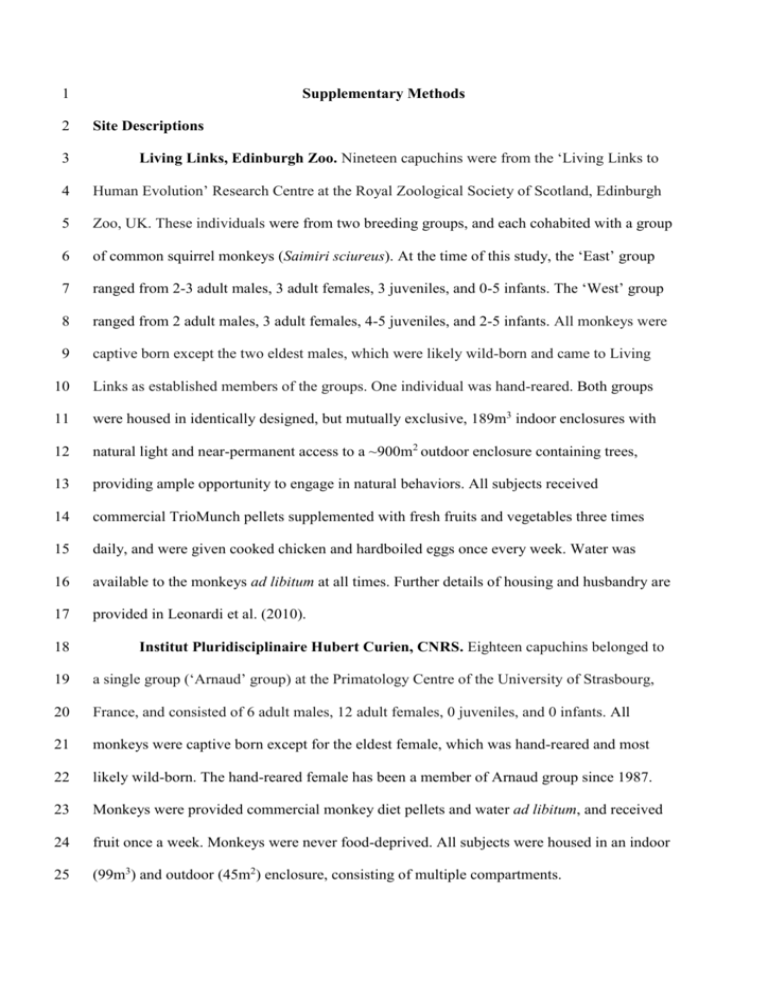
1 2 Supplementary Methods Site Descriptions 3 Living Links, Edinburgh Zoo. Nineteen capuchins were from the ‘Living Links to 4 Human Evolution’ Research Centre at the Royal Zoological Society of Scotland, Edinburgh 5 Zoo, UK. These individuals were from two breeding groups, and each cohabited with a group 6 of common squirrel monkeys (Saimiri sciureus). At the time of this study, the ‘East’ group 7 ranged from 2-3 adult males, 3 adult females, 3 juveniles, and 0-5 infants. The ‘West’ group 8 ranged from 2 adult males, 3 adult females, 4-5 juveniles, and 2-5 infants. All monkeys were 9 captive born except the two eldest males, which were likely wild-born and came to Living 10 Links as established members of the groups. One individual was hand-reared. Both groups 11 were housed in identically designed, but mutually exclusive, 189m3 indoor enclosures with 12 natural light and near-permanent access to a ~900m2 outdoor enclosure containing trees, 13 providing ample opportunity to engage in natural behaviors. All subjects received 14 commercial TrioMunch pellets supplemented with fresh fruits and vegetables three times 15 daily, and were given cooked chicken and hardboiled eggs once every week. Water was 16 available to the monkeys ad libitum at all times. Further details of housing and husbandry are 17 provided in Leonardi et al. (2010). 18 Institut Pluridisciplinaire Hubert Curien, CNRS. Eighteen capuchins belonged to 19 a single group (‘Arnaud’ group) at the Primatology Centre of the University of Strasbourg, 20 France, and consisted of 6 adult males, 12 adult females, 0 juveniles, and 0 infants. All 21 monkeys were captive born except for the eldest female, which was hand-reared and most 22 likely wild-born. The hand-reared female has been a member of Arnaud group since 1987. 23 Monkeys were provided commercial monkey diet pellets and water ad libitum, and received 24 fruit once a week. Monkeys were never food-deprived. All subjects were housed in an indoor 25 (99m3) and outdoor (45m2) enclosure, consisting of multiple compartments. 26 Language Research Center, Georgia State University. Twelve capuchins belonged 27 to two groups at the Georgia State University (GSU) in Atlanta, Georgia, USA. The ‘Griffin’ 28 group consisted of 2 adult males, 2 adult females, 2 juveniles, and 0 infants. The ‘Gabe’ 29 group consisted of 1 adult male, 2 sub-adult males, 2 adult females, 1 juvenile, and 0 infants. 30 All monkeys were captive born. For both groups, enclosures consisted of an indoor room 31 (Gabe group: 75.84m3; Griffin group: 54.42m3) connected to a large outdoor enclosure (Gabe 32 group: 13.51m2; Griffin group: 21.15m2). Group members spent most of their time in the 33 outdoor area throughout the year, except when engaged in research, during bad weather, or 34 overnight. Monkeys were provided commercial monkey chow three times a day (morning, 35 noon, evening), and fruits and vegetables were given every evening. Water was available ad 36 libitum at all times, including during cognitive and behavioral testing. The enclosures were 37 made of chain link fencing and were equipped with swings, ropes, and other materials to 38 create three-dimensional living conditions to enrich the monkeys. The older study subjects 39 had previously been housed together in various combinations at Yerkes National Primate 40 Research Center, before being relocated to GSU 5 years ago. 41 Bucknell Primate Lab, Bucknell University. Fourteen of the primates belonged to a 42 single group at Bucknell University in Lewisburg, Pennsylvania, USA. They were housed in 43 one social group consisting of 2 adult males, 2 adult females, 5 sub-adult females, 5 44 juveniles, and 0 infants. All monkeys were captive born. The enclosure consisted of a series 45 of seven compartments (totaling 630m3) made of caging wire, which were interconnected by 46 doorways or tunnels also made of caging wire. The compartments included various perches, 47 swings, and poles to ensure a most naturalistic environment for climbing and movement. 48 Monkeys were provided commercial monkey chow twice per day (morning, evening), fruits 49 and vegetables were given once per day (morning), and an afternoon snack consisting largely 50 of peanuts, raisins, and low-sugar cereal was given in the afternoon. Water was available ad 51 libitum at all times. The older subjects (N = 4) had previously been housed at Yerkes 52 National Primate Research Center before being relocated to Bucknell University 12 years 53 ago. 54 Living Links, Yerkes National Primate Research Center, USA. Twenty-six brown 55 capuchin monkeys housed in two separate social groups at Living Links, part of the Yerkes 56 National Primate Research Center. One group consisted of 15 monkeys housed in 25 m2, and 57 the other of 11 monkeys in 31 m2. Both groups had access to indoor and outdoor areas and 58 were visually, but not acoustically isolated from each other. The monkeys received Purina 59 monkey chow and water ad libitum, and trays containing fresh produce every evening. 60 Monkeys were never food or water deprived and all procedures were approved by the 61 Institutional Animal Care and Use Committee (IACUC) prior to the commencement of the 62 study. 63 Laboratory of Comparative Ethology, National Institutes of Health. Twenty-six 64 capuchins came from two captive breeding group and several small bachelor groups at the 65 Laboratory of Comparative Ethology, NICHD. At the time of the study, one group (Garth’s 66 group) comprised 5 adults (4 female and 1 male, aged 7-30 years) and 4 juveniles (2 female 67 and 2 male, aged 1-3 years). Three infants (1 female and 2 male, aged <6 months) were part 68 of the group but were not rated for the current study. The second breeding group (Manuel’s 69 group) comprised 4 adults (3 female and 1 male, aged 5-12 years) and 4 juveniles (1 female 70 and 3 male, aged 2-4 years). A further nine animals were pair-housed in cages; two pairs and 71 a group of 3 animals were subadult to adult males (aged 4-9 years), and one pair was an adult 72 female with a juvenile male (aged 25 and 1 year respectively). All monkeys were captive 73 born, mother-reared, and housed in the LCE primate facilities at the NIH Animal Center near 74 Poolesville, MD. Breeding groups were housed in one or two parts of three indoor runs (6.9 x 75 4.1 x 2.1m each) which were connected via sliding doors. Runs were furnished with swings, 76 ladders and various platforms. Cage-housed monkeys were housed in quad cages (1.63 x 1.63 77 x .71 m per pair). All monkeys were provided with a variety of plastic and metal 78 manipulanda. Monkeys were not food deprived for this study, and received daily nutritional 79 supplements of seeds and fresh fruit or nuts. Commercial monkey biscuits (Labdiet 5045) and 80 water were available ad libitum. 81 Comparative Cognition Laboratory, Yale University. Ten monkeys were at the 82 Comparative Cognition Laboratory at Yale University, New Haven, Connecticut, USA. This 83 group consisted of 4 adult males, 4 adult females, and 2 juvenile females. All monkeys were 84 captive born. The monkeys were housed in an indoor enclosure (32 m3) consisting of multiple 85 compartments. Commercial monkey pellets were provided twice daily (morning, afternoon) 86 and supplemented with fruits, vegetables, nuts, and cereal daily. Water was available ad 87 libitum. 88 Capuchin Personality 5 89 Table S1 90 Structure Matrix of Varimax- and Promax-Rotated Component Loadings for the Six Component Solution Varimax Rotated Components Asst Submissive Open Attn Promax Rotated Components Neur Socb Enga h2 Asst Open Attn Neur Socb Enga h2 -.92 -.10 .01 -.15 -.18 .00 .90 -.93 .07 -.04 -.18 -.17 .07 .90 Bullying .91 -.01 .06 -.18 -.06 .04 .88 .97 -.16 -.01 -.15 -.04 .00 .88 Aggressive .90 .05 .07 -.19 -.08 .03 .86 .94 -.09 .00 -.15 -.07 -.01 .86 Stingy/Greedy .86 .02 .04 -.17 .05 .21 .81 .90 -.13 .02 -.16 .08 .18 .81 Jealous .80 .17 .03 -.21 .03 .26 .78 .80 .04 .00 -.21 .06 .23 .78 Gentle -.79 -.11 -.15 .40 .11 .08 .84 -.85 .01 -.02 .36 .09 .09 .84 Dominant .79 -.24 -.01 .06 .04 .42 .87 .85 -.39 .04 .07 .10 .39 .87 Vulnerable -.79 -.07 .16 -.19 -.22 .04 .74 -.81 .08 .11 -.19 -.18 .11 .74 Timid -.71 -.44 .10 -.28 -.21 -.05 .85 -.63 -.34 .00 -.31 -.14 .02 .85 Cautious -.71 -.46 .05 -.14 -.13 .08 .76 -.64 -.37 .01 -.18 -.05 .15 .76 .63 .42 -.03 .02 .21 -.18 .66 .59 .31 -.03 .03 .15 -.23 .66 -.62 -.32 .29 -.39 -.21 .00 .76 -.55 -.23 .19 -.39 -.10 .09 .76 Manipulative Fearful Capuchin Personality 6 Varimax Rotated Components Asst Irritable Open Attn Promax Rotated Components Neur Socb Enga h2 Asst Open Attn Neur Socb Enga h2 .62 -.05 .04 -.41 -.27 .15 .65 .67 -.12 -.11 -.40 -.25 .15 .65 -.61 .12 .25 -.30 .28 -.24 .67 -.61 .16 .23 -.33 .35 -.15 .67 .61 .13 -.03 .48 -.28 .10 .71 .55 .12 .06 .59 -.35 .00 .71 Anxious -.55 -.37 .26 -.34 -.41 -.01 .79 -.47 -.26 .14 -.32 -.32 .06 .79 Reckless .51 .47 .48 -.13 .01 .21 .76 .43 .40 .53 -.04 .09 .22 .76 Autistic -.43 -.24 .21 -.09 -.42 .05 .47 -.41 -.12 .15 -.04 -.38 .08 .47 Protective .42 -.02 -.30 .23 .30 -.02 .41 .43 -.12 -.24 .19 .24 -.08 .41 Inventive .12 .86 -.09 .12 .07 .22 .82 -.09 .90 -.03 .12 -.03 .19 .82 Inquisitive .19 .84 .04 .05 .23 .18 .83 .00 .84 .13 .06 .18 .17 .83 Innovative .07 .84 -.15 .08 .09 .20 .79 -.14 .89 -.11 .06 -.02 .18 .79 Playful .08 .83 .11 -.09 .25 .02 .77 -.09 .83 .15 -.09 .21 .03 .77 Active .05 .81 -.11 -.33 .24 -.08 .85 -.09 .82 -.19 -.39 .15 -.07 .85 Conventional -.12 -.79 -.22 .17 .09 -.02 .72 .04 -.84 -.19 .12 .13 -.02 .72 Lazy -.07 -.71 .32 .32 -.18 .06 .74 .06 -.72 .43 .42 -.05 .06 .74 Dependent/Follower Independent Capuchin Personality 7 Varimax Rotated Components Asst Imitative Open Attn Promax Rotated Components Neur Socb Enga h2 Asst Open Attn Neur Socb Enga h2 -.02 .68 -.05 -.04 .38 .03 .62 -.16 .67 .00 -.08 .34 .04 .62 Defiant .48 .59 .25 -.07 -.13 .03 .66 .37 .58 .24 .02 -.16 .01 .66 Quitting .00 -.40 .37 -.06 .01 -.31 .40 .13 -.46 .37 .01 .11 -.29 .40 Disorganized -.22 .04 .79 -.07 -.26 -.08 .75 -.22 .10 .83 .09 -.12 -.02 .75 Unperceptive .03 -.07 .78 -.10 -.08 -.01 .64 .08 -.10 .85 .04 .11 .04 .64 Thoughtless -.12 .01 .74 -.15 -.16 .33 .72 -.12 .02 .82 -.03 .05 .41 .72 Distractible .08 .01 .70 -.27 .31 -.25 .72 .16 -.10 .74 -.20 .49 -.18 .72 Clumsy -.17 -.21 .68 .15 .06 -.15 .58 -.11 -.23 .81 .28 .22 -.10 .58 Erratic .11 .30 .61 -.41 -.25 -.13 .72 .10 .31 .52 -.30 -.16 -.08 .72 Impulsive .03 .46 .50 -.49 -.16 -.08 .73 -.02 .48 .40 -.42 -.09 -.02 .73 Helpful -.22 .23 -.45 .34 .25 .14 .50 -.32 .27 -.35 .26 .14 .10 .50 Sensitive -.29 -.06 -.38 .28 .29 .00 .40 -.32 -.04 -.30 .20 .22 -.02 .40 Intelligent .09 .37 -.38 .29 .02 .03 .38 -.02 .41 -.34 .27 -.12 -.03 .38 Cool .17 .04 -.30 .78 .14 .17 .78 .09 .02 -.08 .80 .05 .08 .78 Capuchin Personality 8 Varimax Rotated Components Asst Open Attn Promax Rotated Components Neur Socb Enga h2 Asst Open Attn Neur Socb Enga h2 Unemotional .01 -.12 -.04 .75 .16 -.09 .61 -.01 -.13 .19 .81 .13 -.16 .61 Excitable .00 .12 .54 -.63 -.03 -.07 .70 .05 .09 .42 -.60 .11 .02 .70 Predictable -.08 -.43 -.05 .60 .05 .06 .56 -.05 -.43 .13 .64 .06 .02 .56 Sympathetic -.35 .06 -.28 .49 .35 .02 .57 -.41 .08 -.11 .45 .29 .00 .57 Sociable .21 .26 .05 .18 .82 .10 .84 .17 .10 .26 .12 .89 .11 .84 Solitary -.39 -.33 .03 .02 -.74 -.16 .84 -.35 -.16 -.10 .10 -.79 -.16 .84 Affectionate -.15 .14 -.02 .33 .74 .02 .70 -.19 .05 .21 .27 .78 .03 .70 Friendly -.32 .22 -.24 .22 .69 .06 .74 -.38 .18 -.08 .11 .69 .07 .74 Depressed -.44 -.35 .26 -.04 -.65 -.03 .81 -.40 -.19 .18 .05 -.62 .00 .81 Individualistic -.07 .33 .29 .26 -.43 -.07 .46 -.17 .45 .32 .40 -.48 -.10 .46 Persistent .27 .26 .03 -.07 -.01 .82 .81 .17 .23 .12 -.09 .06 .83 .81 Curious .05 .46 .02 -.09 .19 .73 .79 -.09 .45 .12 -.15 .25 .76 .79 Decisive .36 .08 -.32 .30 .07 .62 .72 .28 .03 -.20 .26 .04 .57 .72 -.02 -.13 -.24 .42 .16 .59 .62 -.07 -.14 -.05 .38 .17 .57 .62 Stable Capuchin Personality 9 Varimax Rotated Components Asst SS loadings Proportion of Variance Open Attn Promax Rotated Components Neur Socb Enga Asst Open Attn Neur Socb Enga 11.02 8.39 5.74 5.11 4.84 2.98 10.91 8.39 5.54 5.39 4.94 2.90 .20 .16 .11 .09 .09 .06 .20 .16 .10 .10 .09 .05 91 Note. Salient loadings are in boldface. h2 = communality. Asst = Assertiveness (reversed), Open = Openness, Attn = Attentiveness, Neur = 92 Neuroticism, Socb = Sociability, Engag = Engagement. 93 Capuchin Personality 10 Table S2 Correlations Between Promax Rotated Components Assertiveness Openness Attentiveness Neuroticism Sociability Openness -.35 Attentiveness .02 -.05 Neuroticism -.05 .01 -.45 Sociability -.04 .26 -.38 .25 Engagement -.13 .03 -.17 .18 -.06


